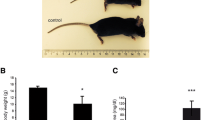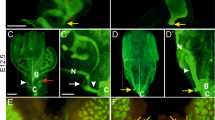Abstract
Despite the increasing interest in other classes of small RNAs, microRNAs (miRNAs) remain the most widely investigated and have been shown to play a role in a number of different processes in mammals. Many studies investigating miRNA function focus on the processing enzyme Dicer1, which is an RNAseIII protein essential for the biogenesis of active miRNAs through its cleavage of precursor RNA molecules. General deletion of Dicer1 in the mouse confirms that miRNAs are essential for development because embryos lacking Dicer1 fail to reach the end of gastrulation. Here we investigate the role of Dicer1 in urogenital tract development. We utilised a conditional allele of the Dicer1 gene and two Cre-expressing lines, driven by HoxB7 and Amhr2, to investigate the effect of Dicer1 deletion on both male and female reproductive tract development. Data presented here highlight an essential role for Dicer1 in the correct morphogenesis and function of the female reproductive tract and confirm recent findings that suggest Dicer1 is required for female fertility. In addition, HoxB7:Cre-mediated deletion in ureteric bud derivatives leads to a spectrum of anomalies in both males and females, including hydronephrotic kidneys and kidney parenchymal cysts. Male reproductive tract development, however, remains largely unaffected in the absence of Dicer1. Thus, Dicer1 is required for development of the female reproductive tract and also normal kidney morphogenesis.




Similar content being viewed by others
References
Andreu-Vieyra C, Chen R, Matzuk MM (2007) Effects of granulosa cell-specific deletion of Rb in Inha-alpha null female mice. Endocrinology 148:3837–3849
Bernstein E, Kim SY, Carmell MA, Murchison EP, Alcorn H et al (2003) Dicer is essential for mouse development. Nat Genet 35:215–217
Brenner-Anantharam A, Cebrian C, Guillaume R, Hurtado R, Sun TT et al (2007) Tailbud-derived mesenchyme promotes urinary tract segmentation via BMP4 signaling. Development 134:1967–1975
Carroll TJ, Park JS, Hayashi S, Majumdar A, McMahon AP (2005) Wnt9b plays a central role in the regulation of mesenchymal to epithelial transitions underlying organogenesis of the mammalian urogenital system. Dev Cell 9:283–292
Caubit X, Lye CM, Martin E, Coré N, Long DA et al (2008) Teashirt 3 is necessary for ureteral smooth muscle differentiation downstream of SHH and BMP4. Development 135:3301–3310
Chiu MG, Johnson TM, Woolf AS, Dahm-Vicker EM, Long DA et al (2006) Galectin-3 associates with the primary cilium and modulates cyst growth in congenital polycystic kidney disease. Am J Pathol 169:1925–1938
Clarke JC, Patel SR, Raymond RM Jr, Andrew S, Robinson BG et al (2006) Regulation of c-Ret in the developing kidney is responsive to Pax2 gene dosage. Hum Mol Genet 15:3420–3428
Gresh L, Fischer E, Reimann A, Tanguy M, Garbay S et al (2004) A transcriptional network in polycystic kidney disease. EMBO J 23:1657–1668
Guioli S, Sekido R, Lovell-Badge R (2007) The origin of the Mullerian duct in chick and mouse. Dev Biol 302:389–398
Hannema SE, Hughes IA (2007) Regulation of Wolffian duct development. Horm Res 67:142–151
Harfe BD, McManus MT, Mansfield JH, Hornstein E, Tabin CJ (2005) The RNAseIII enzyme Dicer is required for morphogenesis but not patterning of the vertebrate limb. Proc Natl Acad Sci USA 102:10898–10903
Harris KS, Zhang Z, McManus MT, Harfe BD, Sun X (2006) Dicer function is essential for lung epithelium morphogenesis. Proc Natl Acad Sci USA 103:2208–2213
Harvey SJ, Jarad G, Cunningham J, Goldberg S, Schermer B et al (2008) Podocyte-specific deletion of Dicer alters cytoskeletal dynamics and causes glomerular disease. J Am Soc Nephrol 19:2150–2158
Hong X, Luense LJ, McGinnis LK, Nothnick WB, Christenson LK (2008) Dicer1 is essential for female fertility and normal development of the female reproductive system. Endocrinology 149:6207–6212
Hough TA, Nolan PM, Tsipouri V, Toye AA, Gray IC et al (2002) Novel phenotypes identified by plasma biochemical screening in the mouse. Mamm Genome 13:595–602
Jamin SP, Arango NA, Mishina Y, Hanks MC, Behringer RR (2002) Requirement of Bmpr1a for Mullerian duct regression during male sexual development. Nat Genet 32:408–410
Jamin SP, Arango NA, Mishina Y, Hanks MC, Behringer RR (2003) Genetic studies of the AMH/MIS signaling pathway for Mullerian duct regression. Mol Cell Endocrinol 211:15–19
Jorgez CJ, Klysik M, Jamin SP, Behringer RR, Matzuk MM (2004) Granulosa cell-specific inactivation of follistatin causes female fertility defects. Mol Endocrinol 18:953–967
Kobayashi A, Behringer RR (2003) Developmental genetics of the female reproductive tract in mammals. Nat Rev Genet 4:969–980
Kobayashi A, Shawlot W, Kania A, Behringer RR (2004) Requirement of Lim1 for female reproductive tract development. Development 131:539–549
Maatouk DM, Loveland KL, McManus MT, Moore K, Harfe BD (2008) Dicer1 is required for differentiation of the mouse male germline. Biol Reprod 79:696–703
Mishina Y, Rey R, Finegold MJ, Matzuk MM, Josso N et al (1996) Genetic analysis of the Mullerian-inhibiting substance signal transduction pathway in mammalian sexual differentiation. Genes Dev 10:2577–2587
Murchison EP, Stein P, Xuan Z, Pan H, Zhang MQ et al (2007) Critical roles for Dicer in the female germline. Genes Dev 21:682–693
Nagaraja AK, Andreu-Vieyra C, Franco HL, Ma L, Chen R et al (2008) Deletion of Dicer in somatic cells of the female reproductive tract causes sterility. Mol Endocrinol 22:2336–2352
Orvis GD, Behringer RR (2007) Cellular mechanisms of Mullerian duct formation in the mouse. Dev Biol 306:493–504
Otsuka M, Zheng M, Hayashi M, Lee JD, Yoshino O et al (2008) Impaired microRNA processing causes corpus luteum insufficiency and infertility in mice. J Clin Invest 118:1944–1954
Oxburgh L, Chu GC, Michael SK, Robertson EJ (2004) TGFbeta superfamily signals are required for morphogenesis of the kidney mesenchyme progenitor population. Development 131:4593–4605
Pitera JE, Scambler PJ, Woolf AS (2008) Fras1, a basement-membrane-associated protein mutated in Fraser syndrome, mediates both the initiation of the mammalian kidney and the integrity of renal glomeruli. Hum Mol Genet 17:3953–3964
Rao MK, Pham J, Imam JS, MacLean JA, Murali D et al (2006) Tissue-specific RNAi reveals that WT1 expression in nurse cells controls germ cell survival and spermatogenesis. Genes Dev 20:147–152
Roberts LM, Hirokawa Y, Nachtigal MW, Ingraham HA (1999) Paracrine-mediated apoptosis in reproductive tract development. Dev Biol 208:110–122
Rojek A, Fuchtbauer EM, Kwon TH, Frokiaer J, Nielsen S (2006) Severe urinary concentrating defect in renal collecting duct-selective AQP2 conditional-knockout mice. Proc Natl Acad Sci USA 103:6037–6042
Shi S, Yu L, Chiu C, Sun Y, Chen J et al (2008) Podocyte-selective deletion of Dicer induces proteinuria and glomerulosclerosis. J Am Soc Nephrol 19:2159–2169
Vainio S, Heikkila M, Kispert A, Chin N, McMahon AP (1999) Female development in mammals is regulated by Wnt-4 signalling. Nature 397:405–409
Warr N, Siggers P, Bogani D, Brixey R, Pastorelli L et al (2009) Sfrp1 and Sfrp2 are required for normal male sexual development in mice. Dev Biol. doi:10.1016/j.ydbio.2008.11.023
Welsh M, Saunders PT, Sharpe RM (2007) The critical time window for androgen-dependent development of the Wolffian duct in the rat. Endocrinology 148:3185–3195
Whiting J, Marshall H, Cook M, Krumlauf R, Rigby PW et al (1991) Multiple spatially specific enhancers are required to reconstruct the pattern of Hox-2.6 gene expression. Genes Dev 5:2048–2059
Yi R, O’Carroll D, Pasolli HA, Zhang Z, Dietrich FS et al (2006) Morphogenesis in skin is governed by discrete sets of differentially expressed microRNAs. Nat Genet 38:356–362
Yu J, Carroll TJ, McMahon AP (2002) Sonic hedgehog regulates proliferation and differentiation of mesenchymal cells in the mouse metanephric kidney. Development 129:5301–5312
Zhao H, Kegg H, Grady S, Truong HT, Robinson ML et al (2004) Role of fibroblast growth factor receptors 1 and 2 in the ureteric bud. Dev Biol 276:403–415
Acknowledgments
The authors would particularly like to thank Nick Warr, Debora Bogani, Rachel Brixey, and Pam Siggers in the Sexual Development group at MGU, MRC Harwell for advice and support. We thank the staff of the Mary Lyon Centre (MLC) at MRC Harwell for support in animal husbandry, especially Lucie Vizor, Rose Kent, Dan Andrew, and Jackie Harrison. We thank Jim Humphrey, Dave Shipston, and Kate Vowell of the necropsy team of the MLC for assistance with dissections and the histology team for support in sectioning. We are grateful to Kan Pai Chiev for assistance with clinical chemistry. We thank Sue Rodger of the FESA team of the Mammalian Genetics Unit (MGU) for support in rederivation and analysis of preimplantation embryos. We are also grateful to Richard Behringer for supplying Amhr2:Cre mice. Support in statistics was kindly provided by Pete Underhill. Animal procedures used in this study were authorised by UK Home Office Project License PPL 30/2381. ASW acknowledges project grant support from Kidney Research UK and the Wellcome Trust.
Author information
Authors and Affiliations
Corresponding author
Rights and permissions
About this article
Cite this article
Pastorelli, L.M., Wells, S., Fray, M. et al. Genetic analyses reveal a requirement for Dicer1 in the mouse urogenital tract. Mamm Genome 20, 140–151 (2009). https://doi.org/10.1007/s00335-008-9169-y
Received:
Accepted:
Published:
Issue Date:
DOI: https://doi.org/10.1007/s00335-008-9169-y




